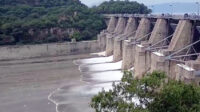Industrialization is the period of social and economic change that transforms a human group from an agrarian society into an industrial society. This involves an extensive re-organization of an economy for the purpose of manufacturing. It is change from an agrarian and handicraft economy to one dominated by industry and machine manufacturing.
Pakistan’s industrial sector accounts for about 64% of GDP. Cotton textile production and apparel manufacturing are Pakistan’s largest industries, accounting for about 65% of the merchandise exports and almost 40% of the employed labour force. Other major industries include cement, fertilizer, edible oil, sugar, steel, tobacco, chemicals, machinery and food processing.
Without a doubt, Industrialization is a central pillar of the development of economy of any country. This study emphasis on environmental conflicts associated with industrialization and their weak governance system, which is taking important place in the economic, social and environmental science literature. In fact, there are many flaws to the way of industrial management system. Even though we can currently do things much more efficiently than before, but the cost of this efficiency may seem inexpensive in many ways, however we do not realize that the cost of these new technologies do not just include money, time and labour, but it also costs us our wellbeing as well as earth. There are four primary impact points when it comes to industrialization — air, water, soil and habitat. The biggest problem is air pollution, caused by the smoke and emissions generated by burning fossil fuels. This is also a fact that rapid industrial growth has made water, air and hazardous waste pressing environmental problem in many areas of the developing world. Industrial emissions combine with vehicle exhausts caused extensive air pollution, while concentrations of heavy metals and ammonia loads are often high enough to cause major threat to life down-river from industrial areas. Soil contamination is another problem that goes hand in hand with industrialization. Lead is the most common form of soil contamination, but other heavy metals and toxic chemicals can also leach into the soil and, in turn, contaminate any crops that grow there. The lack of hazardous waste facilities compounds the problem, with industrial wastes often discarded on fallow or public lands, in rivers, or in sewers designed to carry only municipal wastes.
To have a look on the relationships between industrial expansion, environmental hazards caused and policies to deal with both in Pakistan, it is clear that there is an urgent need for revision of governance structures to deal with such cases. Although data is scarce, it is clear that industrial pollution is increasing rapidly and connected health and productivity impacts are significantly worsening. Major industrial contributors to water pollution are the pulp and paper, chemicals, petrochemicals, refining, metalworking, food processing and textile industries; power generation for various industrial purposes and brick kilns are major sources of air pollution. Industrial pollution is considered as responsible for the health and environmental threats. Besides the air pollution, the other hazards related to industrial expansion are noise, vibrations, greenhouse effect, radiation, chemicals, electromagnetic radiation and microbiological and social problems like stress and fatigue. Moreover, the chromium compounds are a typical cause of concern from dyes and tanneries and may lead to lung cancer and ulcers. Literature articulates that the waste management and preventing or abating pollution are two of the fourteen core program areas of the National Conservation Strategy (NCS) of Pakistan, approved in 1992. Pakistan Environmental Protection Act 1997 provides for the protection of the environment, pollution control and the promotion of sustainable development. Section 11 of this Act prohibits any discharge or emission into the environment with levels above the existing National Environmental Quality Standards (NEQS), where the sections 13 and 14 are dealing with hazardous wastes and hazardous substances, respectively. A recent initiative to implement NEQS is a “Self-Monitoring and Reporting/SMART” program for industry. The self-monitoring and reporting guidelines were developed through a long and exhaustive series of consultations and roundtable discussions among all stakeholders, including representatives from the government, industry, NGOs, civil society organizations, universities and research and development institutions. Under the self-monitoring and reporting program, industries in Pakistan are made responsible for systematically monitoring their environmental performance and periodically reporting the data to provincial Environmental Protection Agencies (EPAs). It is expected that entrepreneurs who are well aware of their social and legal responsibilities will respond adequately to this new system which does not involve any role for environmental (protection/control) inspectors. The self-monitoring and reporting system takes into account the interests and resources of both the EPAs and industry, which may save considerable time, efforts and money, of the EPAs, which further involves industry in evaluating environmental performance, leading to pollution controls measures. Government, industry and NGOs worked together towards implementing the NEQS through a self-monitoring and reporting program and have gone a long way in developing and testing SMART through a pilot-phase program and reporting/SMART program so far has been due to collaboration and thorough and exhaustive consultation, both for the program development and program implementation with all the stakeholders from the very beginning. Stakeholders such as CCIs, Universities, R&D organizations, and NGOs exist all over the country and have the facilities and the trained personnel to contribute significantly towards this program. They can either provide training and analytical services or initiate activities contributing to awareness-raising. Continued and effective collaboration between policy makers, Universities, research and development organizations and industry would further ensure the success and sustainability of this program. Now that we’ve realized what an impact the industrial revolution has had and is still having on the environment, There are two possible approaches that both factories and legislators can take to help reduce the impact of industrial pollution. First, industries can reduce their reliance on a product that is causing pollution. One good example is removing lead from gasoline in the 1970s. The other option is to treat industrial waste to remove toxic components so that the rest of the waste can be disposed of safely. Some measures taken for controlling air pollution from industries are; Industries have been directed to install necessary pollution control equipment in a time bound manner and legal action has been initiated against the defaulting units. Environmental guidelines have evolved for siting industries and environmental clearance is made compulsory for 29 categories of development projects involving public hearing/NGO participation as an important component of Environmental Impact Assessment process. Use of cleaner technologies is a new dimension emerging rapidly for cleaner production and to increase production efficiency, and at the same time eliminate or at least minimise emission and waste at their source. The industrial revolution may have changed the way that we look at the world, but it also changed the impact we had on this planet that we call home. Now that we’ve realized the problem, it’s up to us to fix it so that we can continue to grow and change without destroying our home in the name of progress.
Stay tuned to Baaghi TV for more. Download our app for the latest news, updates & interesting content!






